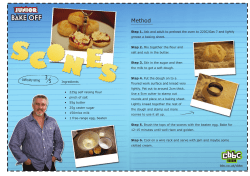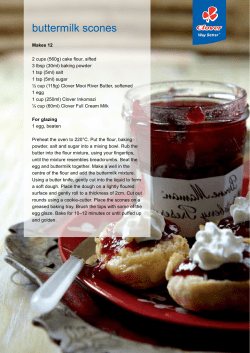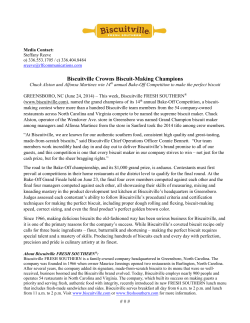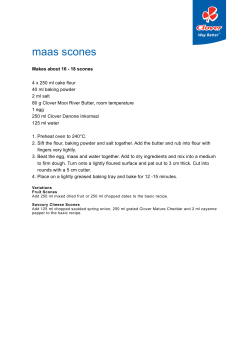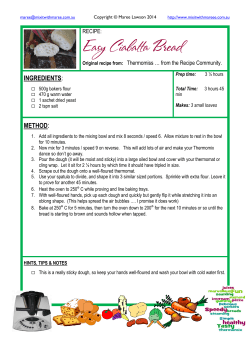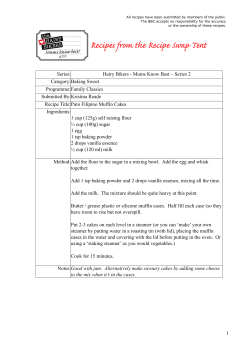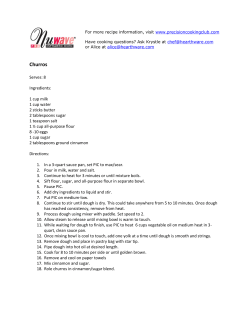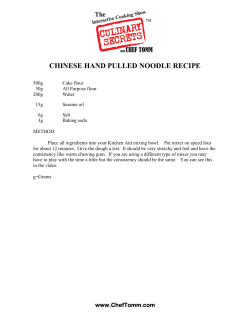
Biscuits UNIT 3
4JH-03PC UNIT 3 Biscuits By Sue Burrier, former Extension Specialist in Foods and Nutrition, and Anna Lucas, former Extension Program Specialist for 4-H Revised by Paula May, M.S., R.D., Nutrition Consultant, Sandra Bastin, Ph.D., R.D., Specialist in Foods and Nutrition, and Rosie Allen, EFNEP Consultant, Gallatin County Introduction Biscuits are popular as a hot bread for breakfast and other meals. They are a type of quick bread. Biscuits are usually baked in an oven, but if you are on a camping trip, you can use a heavy covered skillet for an oven. Biscuits can be plain or fancy; part of a main dish; served as breakfast rolls; or made into coffee cakes, desserts, or beaten biscuits. They can be flavored with fruits, vegetables, cheese, meat, herbs, or spices. As fast and easy as you please, you can have biscuits for breakfast, lunch, or dinner. You will learn: • The role of each ingredient in biscuits. • The equipment and ingredients needed for making biscuits. • The correct and safe use of the oven. • How to make biscuits using all-purpose (plain), selfrising, and whole wheat flours. • How to make buttermilk and sweet milk biscuits. You will also: • Use standard measuring equipment and preparation methods. • Prepare a variety of biscuits, including regular, dropped, and potato biscuits, as well as snack treats made of biscuits, such as cinnamon twists. • Give a demonstration to show others what you have learned in this project. • Keep a record of what you have done in this project. Self-rising flour is all-purpose flour with the salt and leavening agent already added for convenience. One cup of selfrising flour contains 11/2 teaspoons baking powder and 1/2 teaspoon salt. This type of flour works well for biscuits but is not recommended for yeast breads. What Bread Does for You Biscuits fit in the Bread, Cereal, Rice, and Pasta Group of the Food Guide Pyramid. They give you nutrients that are important to your health and provide energy for work and play. The most important nutrients they provide are carbohydrates, fat, and B vitamins for energy; calcium for strong bones and teeth; and protein for growth and repair. They also provide minerals, including iron. All of the white flour used in making biscuits is enriched. Enrichment means that the nutrients lost in the milling process—thiamin, riboflavin, niacin, and iron—have been restored. In addition, grain products are now fortified with folate, a B vitamin. LEAVENING AGENTS—Leavening agents are substances that help bread dough rise. Biscuits are quick breads made with leavening agents that react quickly. These breads can be baked at once and do not require a rising period before baking. Low-sodium baking powder may be purchased if anyone in the family is on a low-sodium diet. The leavening agent most often used for biscuits is either (1) baking soda plus an acid or (2) baking powder. If a recipe calls for soda, it also calls for an acid, such as buttermilk. Ingredients for Making Bread LIQUID—Milk is needed to moisten the flour, dissolve the salt, and permit the leavening agents to release gas (carbon dioxide—CO2) that helps the bread to rise. Milk also contributes nutrients and helps the bread to brown. Different types of milk work successfully in baking. Whole, reduced-fat, lowfat, fat-free, reconstituted dry, and buttermilk can all be used in making biscuits. Biscuits are made with flour, leavening agents, milk, fat or shortening, salt, and sometimes sugar and eggs. FLOUR—Flour made from wheat is the main ingredient. If you completed Quick Batter Breads (4JH-02PA), you learned that white and off-white (unbleached) flours are made from the endosperm of wheat. All-purpose flour is a white flour made from a blend of different types of wheat. This type of flour produces the best results for many products made in the home, including quick breads, such as biscuits. Whole wheat (also called stone-ground and graham) flour is made from the entire wheat kernel. SHORTENING OR FATS—Shortening helps make biscuits tender and gives them a flaky crumb. Fats, such as butter and margarine, also add flavor and color. Solid fat is the better choice for a quality biscuit; however, if a family member is trying to cut back on saturated fats, you might try a recipe using oil. Biscuits made with oil are not as light and flaky as those made with shortening or solid fats. 2 SALT—In some recipes, salt is added for its own flavor. In other recipes, salt is used to bring out the flavor of other ingredients. Salt contains sodium, which some people are advised to limit in their diet. Salt may be reduced or even eliminated in most recipes. Remember that our taste for salt is learned. When you cut back on salt, the product will at first seem bland, but gradually you will adjust to—and even prefer—this new taste. • Serve biscuits hot for better flavor. • Cool biscuits before storing. Then wrap them in plastic wrap or foil and place them in a bread box or freeze them either in a freezer container or wrapped with moistureor vapor-proof material. Cleaning Up To be invited back into the kitchen, always clean up your work area after you cook. Put the ingredients away; wash, rinse, dry, and put away all the equipment you used; wipe off the counters; and clean up any spills on the floor. Before You Begin to Cook • • • • Wash your hands. Read the recipe. Assemble the equipment and ingredients. Check the oven to be sure the rack is in the center; set the temperature and turn the oven on. Let’s Start Baking Talk with the person in your family who does most of the cooking. Select a time to begin your project when the family would enjoy having biscuits. Also, be sure it is convenient for you to prepare biscuits while other parts of the meal are being prepared. Start with a basic biscuit recipe. Then, for other meals, select biscuits that are most suited to the type of meal being served. You may want to make sesame seed twists for a buffet meal or snack pizzas when friends are coming for a visit. Tips for Baking, Serving, and Storing Biscuits • Use standard measuring cups—liquid and dry—and measuring spoons. Use the back of a table knife or a spatula to level the dry ingredients. • For best results in baking, sift the flour before measuring it. Most all-purpose flours are now presifted at the mill so that sifting before using is not essential. Presifted flour should be stirred in the canister to lighten it before gently spooning it into a dry measuring cup. Recipes in this publication will recommend sifting to produce a superior product. • Sift other dry ingredients with the flour to blend them. • Combine the ingredients in the order given. • To measure solid shortening, pack it into a dry measuring cup with a spatula. Remove air pockets by running the spatula through the shortening. Level off with a spatula or knife. • For tender biscuits, stir the ingredients together just enough to blend. Then turn onto a lightly floured board and knead lightly eight to 10 times. Avoid over-mixing or over-kneading, as this will make biscuits less tender. • To shape the dough, use a lightly floured biscuit cutter. Do not twist the cutter because this tends to seal the edges and prevent the biscuit from rising. • For a crisp crust, place the biscuits about an inch apart on the baking sheet. For soft biscuits, place them close together on the sheet. • For a brown finish, brush the tops with milk or butter. • Bake at the correct temperature. Correct and Safe Use of the Oven Ask for help when you first begin to use the oven. Before turning the oven on and setting the temperature, be sure the racks are in the correct place for the size of the pans. The center of the oven or slightly above the center is the best place to bake breads. Bread placed on the lowest rack will burn on the bottom. The oven must be preheated before bread is placed in it to bake. To preheat means to set the oven to the correct temperature, turn it on, and let it heat until it reaches the desired temperature. This step usually takes about 10 minutes. This allows the food to start cooking right away. Foods that take longer to cook, such as a roast, can be placed in a cold oven. When opening a hot oven door, do so gradually to allow hot air to escape. Never reach into a hot oven without a heavy, dry potholder. Always pull the oven rack out before removing any item from the oven. 3 Recipes BAKING POWDER BISCUITS 2 cups sifted, all-purpose flour 3 teaspoons baking powder 3/4 teaspoon salt 1/3 cup shortening 3/4 cup milk * To cut shortening into flour, use a pastry blender or hold two knives together and cut the fat into small, coarse crumbs, blending into the flour. This makes very thin layers of fat coated with flour, which makes a flaky biscuit. Nutrition Facts Per serving: 130 Calories 6 gm Fat 3 gm Protein 17 gm Carbohydrate 280 mg Sodium 0 mg Cholesterol 0 gm Dietary fiber Preheat oven to 450°F. Sift flour and measure. Add baking powder and salt to measured flour and sift together. Cut shortening into flour* until mixture resembles coarse crumbs. Make a well in the center of the ingredients. Add the milk all at once. Stir just enough to hold the dough together (no longer than half a minute). Gather dough into a ball and place on a lightly floured board or pastry cloth. Knead dough gently and quickly about eight to 10 times. Pat or roll dough with a lightly floured rolling pin to 1/2 inch thickness. Cut with lightly floured biscuit cutter. Do not twist the cutter. Place on ungreased baking sheet 1 inch apart for crisp crust or close together for soft biscuits. For a brown finish, brush the tops with milk or butter. Bake until lightly browned, 10 to 12 minutes. YIELD: 12 to 14 biscuits. Food Guide Pyramid 1 serving Bread, Rice, Cereal, and Pasta Group ½ serving Fat, Oils, and Sweets Group SELF-RISING FLOUR BISCUITS Follow recipe for Baking Powder Biscuits but use selfrising flour and omit baking powder and salt. BUTTERMILK BISCUITS 2 cups sifted, all-purpose flour 1 teaspoon baking powder 1/4 teaspoon soda 3/4 teaspoon salt 1/3 cup shortening 3/4 cup buttermilk Preheat oven to 450°F. Sift flour and measure. Add baking powder, soda, and salt to measured flour and sift together. Cut shortening into flour mixture until it resembles coarse crumbs. Make a well in the center of the ingredients. Add the buttermilk all at once. Stir just enough to hold the dough together (no longer than half a minute). Gather dough into a ball and place on a lightly floured board or pastry cloth. Knead dough gently and quickly about eight to 10 times. Pat or roll dough with lightly floured rolling pin to 1/2 inch thickness. Cut with lightly floured biscuit cutter. Do not twist the cutter. 4 Biscuit Variations You can make a variety of biscuits by adding different ingredients to a basic sweet milk or buttermilk biscuit. • Add 1/2 cup grated cheese, chopped candied fruit, grated fruit peel, or chopped, seedless raisins before adding the milk. • Prepare a mixture of sugar and cinnamon (1/2 cup sugar and 1 teaspoon cinnamon) and sprinkle lightly over biscuit tops before baking. • To make pinwheels, roll biscuit dough into an 8-by-12inch rectangle. Spread with 1/4 cup melted butter or margarine and sprinkle with 1/2 to 3/4 cup brown sugar (raisins or nuts may also be added). Roll dough as for jelly roll; cut into 12 slices and place cut side down into a 9-inch greased pan. Bake at 425°F for 10 to 12 minutes. • Substitute whole wheat flour in place of white flour. For lighter biscuits, use 1 cup white flour and 1 cup whole wheat flour. Place on ungreased baking sheet 1 inch apart for crisp crust or close together for soft biscuits. For a brown finish, brush the tops with milk or butter. Bake until lightly browned, 10 to 12 minutes. YIELD: 12 to 14 biscuits. Tips Nutrition Facts Per serving: 100 Calories 4.5 gm Fat 2 gm Protein 13 gm Carbohydrate 170 mg Sodium 0 mg Cholesterol 0 gm Dietary fiber • Biscuits may be frozen unbaked. Place biscuits on a baking sheet, freeze them until firm, and then place them in a freezer bag. Use biscuits as needed. Do not thaw before baking. Baking time may be slightly longer, 12 to 15 minutes, than for fresh biscuits. • To cut back on solid fat, use 1/4 cup shortening. This change may result in a biscuit that is less tender and flaky than the regular recipe. • To make biscuits with oil, use the standard biscuit recipe above. Substitute 1/3 cup vegetable oil for shortening and use 2/3 cup milk. Drop spoonfuls of batter onto a lightly greased baking sheet and bake at 450°F until tops are golden brown, 10 to 12 minutes. • Use leftover mashed potatoes that have been prepared without a lot of added salt and pepper for these biscuits. Or use instant mashed potatoes prepared by following the package directions. Food Guide Pyramid 1 serving Bread, Rice, Cereal, and Pasta Group 1/2 serving Fat, Oils, and Sweets Group DROP BISCUITS Follow recipe for either Baking Powder Biscuits or Buttermilk Biscuits, making the dough softer by increasing the milk to 1 cup. Stir the dough no longer than 1 minute. Drop spoonfuls of batter onto a lightly greased baking sheet and bake at 450°F until tops are golden brown, 10 to 12 minutes. YIELD: 16 biscuits. POTATO BISCUITS 11/4 cups sifted, all-purpose flour 3/ 4 teaspoon salt 3 teaspoons baking powder 3 tablespoons shortening 3/ 4 cup cold mashed potatoes 2/ 3 cup milk, more or less Nutrition Facts Per serving: 100 Calories 4.5 gm Fat 2 gm Protein 13 gm Carbohydrate 65 mg Sodium 0 mg Cholesterol 0 gm Dietary fiber Preheat oven to 400°F. Sift flour and measure. Sift together flour, salt, and baking powder. Cut shortening into flour until mixture resembles coarse crumbs. Stir mashed potatoes into flour mixture. Gradually add enough milk to make a soft dough. Stir just until dough is fairly free from sides of bowl. Food Guide Pyramid 1 serving Bread, Rice, Cereal, and Pasta Group 1/2 serving Fat, Oils, and Sweets Group 5 Knead dough gently and quickly eight to 10 times on a lightly floured board. Roll out dough to about ½ inch thickness with lightly floured rolling pin. Cut with lightly floured biscuit cutter (do not twist cutter) and bake on a lightly greased baking sheet for 12 to 15 minutes. YIELD: 14 to 16 biscuits. SNACK PIZZA 10 to 12 uncooked biscuits 1/ 3 cup tomato sauce 1 teaspoon oregano 1 /2 small, chopped onion 1 /2 cup shredded or thinly sliced cheese Nutrition Facts Per serving: 70 Calories 3 gm Fat 2 gm Protein 10 gm Carbohydrate 230 mg Sodium 0 mg Cholesterol 0 gm Dietary fiber Preheat oven to 400°F. Pat each biscuit into a 4-inch circle on greased cookie sheets. Mix tomato sauce and oregano. Spoon sauce on each biscuit round. Sprinkle onions and cheese over tomato sauce. Bake about 15 minutes or until crust is lightly browned. Refrigerate or freeze extra pizzas. Reheat at 350°F for 5 to 10 minutes if refrigerated and 10 to 15 minutes if frozen. YIELD: 10 to 12 pizzas. Nutrition Facts Per serving: 190 Calories 9 gm Fat 5 gm Protein 21 gm Carbohydrate 460 mg Sodium 5 mg Cholesterol 0.5 gm Dietary fiber Food Guide Pyramid 1 /2 serving Bread, Rice, Cereal, and Pasta Group Snack Treats SESAME SEED TWISTS 1 tablespoon milk 1 egg, beaten 1 recipe of biscuit dough Sesame seeds Food Guide Pyramid 11/2 servings Bread, Rice, Cereal, and Pasta Group 1/ 2 serving Fat, Oils, and Sweets Group Preheat oven to 450°F. Stir milk into beaten egg. Prepare the recipe for biscuits. Cut dough with a 2- to 3-inch biscuit cutter. Stretch each biscuit to about 5 or 6 inches in length. Twist. Dip into egg-milk mixture. Roll in sesame seeds. Place on a lightly greased baking sheet and bake for about 10 minutes. YIELD: 12 to 14 twists. CINNAMON TWISTS 1 recipe biscuit dough 3 tablespoons sugar 1 /4 teaspoon cinnamon 1/ 2 cup finely chopped nuts (optional) 3 tablespoons melted butter or margarine Nutrition Facts Per serving: 140 Calories 6 gm Fat 3 gm Protein 17 gm Carbohydrate 280 mg Sodium 0 mg Cholesterol 0 gm Dietary fiber Preheat oven to 450°F. Prepare one recipe for biscuits. Cut dough with a 21/2- to 3-inch biscuit cutter. Stretch each biscuit to about 5 inches in length. Twist. Combine sugar, cinnamon, and chopped nuts. Roll each biscuit in melted butter or margarine and then in the sugar-nut mixture. Bake on an ungreased baking sheet for about 10 minutes. YIELD: 12 to 14 twists. Nutrition Facts Per serving: 200 Calories 12 gm Fat 4 gm Protein 21 gm Carbohydrate 310 mg Sodium 5 mg Cholesterol 0 gm Dietary fiber Food Guide Pyramid 1 serving Bread, Rice, Cereal, and Pasta Group 1/ 2 serving Fat, Oils, and Sweets Group Food Guide Pyramid 1 serving Bread, Rice, Cereal, and Pasta Group 11/2 servings Fat, Oils, and Sweets Group 6 • • • • Judging Your Bread Each time you bake a biscuit product, evaluate your results. Rate the biscuits for outside appearance, inside crumb, and flavor and aroma. Demonstrations How to make pinwheels. Making biscuits and preparing them for freezing. Making drop biscuits. Comparing texture and flavor of buttermilk and sweet milk biscuits. Citizenship Share what you have learned in the breads project by giving a demonstration. Some suggested topics are: • Biscuit variations. • Buttermilk biscuits. • Cinnamon twists. People who are shut in or cannot cook for themselves will enjoy having you make some bread for them. Others may be able to prepare meals but would appreciate the special treat of freshly baked bread. You may be able to help with a community activity, such as a 4-H meeting, a special program at a nursing home, or an Extension Homemakers or PTA meeting. Biscuit Score Sheet Excellent Appearance Uniform, with straight sides Level top Golden brown top and bottom Free from yellow or brown spots Tender crust; moderately smooth Crumb Slightly moist Medium-fine, even grain Flaky, pulling off in thin sheets Tender, light Flavor and Aroma Well blended Pleasing aroma Free of bitterness 7 Good Needs to Improve Biscuits Project Record Form Name __________________________________ Address _____________________________________________ School ________________________________________________ Grade ________ Birth Date _______________ In filling out this record, summarize information to outline form when appropriate. Put your most important accomplishments at the top of the list. Designate the level of participation with the appropriate letter: local (L), county (C), area (A), state (S), regional (R), national (N), or international (I). Use numbers (digits) to show size or quantity when appropriate. A. List new things you learned in this project or activity. _____________________________________________________________________________________________ _____________________________________________________________________________________________ _____________________________________________________________________________________________ _____________________________________________________________________________________________ B. Show size and scope of this project. (List everything you have done in this project.) _____________________________________________________________________________________________ _____________________________________________________________________________________________ _____________________________________________________________________________________________ _____________________________________________________________________________________________ Type of Bread Number of Times Prepared Comments Biscuits (self rising) Biscuits (plain) Drop biscuits Whole wheat biscuits Cinnamon twists Pizza snacks Sesame twists Other (list) 8 C. List demonstrations, talks, exhibits, radio and television appearances, newspaper articles written, tours, workshops, camps, judging events, and field trips that you participated in throughout this project or activity. ______________________________________________________________________________________________ ______________________________________________________________________________________________ ______________________________________________________________________________________________ ______________________________________________________________________________________________ D. List awards, trips, medals, plaques, trophies, ribbons, scholarships, and other recognition received in this project or activity. ______________________________________________________________________________________________ ______________________________________________________________________________________________ ______________________________________________________________________________________________ ______________________________________________________________________________________________ E. List your leadership participation in this project or activity. Include things you have done by yourself and in cooperation with others in planning 4-H programs; leading discussions; helping younger members with demonstrations, talks, and exhibits; and assisting with camps, achievement shows, and workshops. Indicate the number of 4-H members you have assisted and give your specific responsibilities. ______________________________________________________________________________________________ ______________________________________________________________________________________________ ______________________________________________________________________________________________ ______________________________________________________________________________________________ F. List your citizenship and community service experiences in this project or activity. Include those things that contributed to the welfare of your club or group, other individuals, or your community and give your specific responsibilities. ______________________________________________________________________________________________ ______________________________________________________________________________________________ ______________________________________________________________________________________________ ______________________________________________________________________________________________ G. Attach a short story in which you tell about the things learned, satisfaction experienced, and difficulties encountered this year in this project. 9 Appreciation is expressed to Martha White Foods, Inc., for support of the development of this literature. Educational programs of the Kentucky Cooperative Extension Service serve all people regardless of race, color, age, sex, religion, disability, or national origin. Issued in furtherance of Cooperative Extension work, Acts of May 8 and June 30, 1914, in cooperation with the U.S. Department of Agriculture, M. Scott Smith, Director of Cooperative Extension Service, University of Kentucky College of Agriculture, Lexington, and Kentucky State University, Frankfort. Copyright © 2003 for materials developed by the University of Kentucky Cooperative Extension Service. This publication may be reproduced in portions or its entirety for educational or nonprofit purposes only. Permitted users shall give credit to the author(s) and include this copyright notice. Publications are also available on the World Wide Web at www.ca.uky.edu. Revised 6-2003
© Copyright 2025
